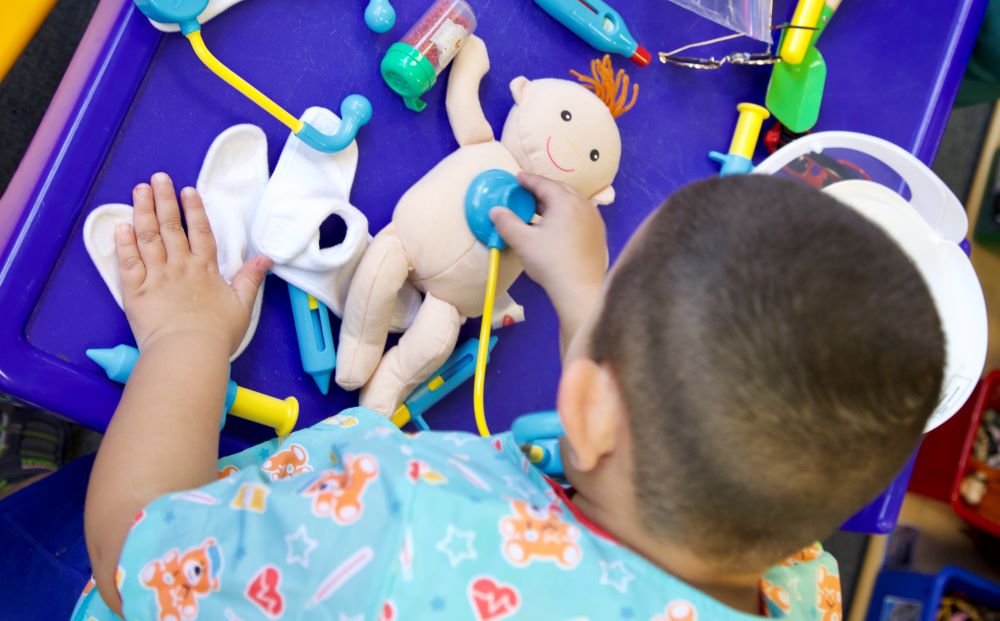 The Head Start program has a rich history, beginning in 1965 as a federal effort to help break the cycle of poverty for preschool children from families with low incomes. Early Head Start was launched in 1995 to serve infants, toddlers, and pregnant women and birthing people in response to the research about early brain development. Today, Head Start programs operate in local communities around the country to help young children, ages birth to 5, from low-income families prepare to succeed in school, promoting children’s development through early learning, health, and family well-being.
The Head Start program has a rich history, beginning in 1965 as a federal effort to help break the cycle of poverty for preschool children from families with low incomes. Early Head Start was launched in 1995 to serve infants, toddlers, and pregnant women and birthing people in response to the research about early brain development. Today, Head Start programs operate in local communities around the country to help young children, ages birth to 5, from low-income families prepare to succeed in school, promoting children’s development through early learning, health, and family well-being.
The Head Start program is administered by the Office of Head Start (OHS) in the Office of Early Childhood Development (ECD) within the Administration for Children and Families (ACF), an agency in the U.S. Department of Health and Human Services (HHS).
OHS has 12 Regional Offices, reflecting 10 geographic regions, and two OHS-specific regions: Region XI, American Indian and Alaska Native (AIAN), and Region XII, Migrant and Seasonal Head Start (MSHS). Regions XI and XII have offices in Washington, DC.
OHS honors the rich cultural heritage of tribal and native children, families, and communities through the AIAN programs. Based on the needs of local communities, Head Start programs offer traditional language and cultural practices to provide high-quality services to young children and their families.
The MSHS programs serve migrant farmworker children, including children of seasonal agricultural workers. MSHS programs serve children from birth to age 5 in many states. They operate from 12 weeks to year-round to accommodate local agricultural industries and harvest seasons. Because both parents typically work in the fields, MSHS programs offer full-day services. Children and families enrolled in MSHS programs are linguistically and culturally diverse, with many children from homes where English is not the primary language. While Spanish is the predominant language, families also speak other languages, including Central/South American Indian and Mexican languages and Haitian Creole.
OHS awards grants to public and private agencies to operate a Head Start program within specific communities. These agencies, also known as grant recipients, can provide services directly to children and families or enter into an agreement with another organization, referred to as a delegate agency, to administer Head Start services. Most Head Start programs are run by non-profit organizations, schools, and community action agencies. Head Start programs work closely with businesses in their communities that may contribute volunteer hours or non-federal donations to support the program’s success. Head Start Collaboration Offices (HSCOs) facilitate partnerships between Head Start agencies and other state, territorial, or tribal entities that provide services to children from families with low incomes.
Head Start programs serve children ages birth to 5 and pregnant women and pregnant people. About 70% of the children enrolled each year are 3- and 4-year-olds who can receive Head Start services until they are eligible for kindergarten. Approximately 30% of the children are infants and toddlers who receive Early Head Start services until age 3, when they can attend a Head Start or another preschool program.
Programs offer Head Start services in various settings or program options such as centers or family child care. Some programs also provide home-based services. In these programs, staff conduct home visits with families and offer group socializations. Programs may also create locally designed options approved by OHS. In some communities, funding is available for Early Head Start-Child Care (EHS-CC) Partnership programs. These programs provide the full array of Head Start services to eligible infants and toddlers whose families are working and need access to full-day, full-year child care.
 Children from birth to age 5 in families with incomes below the poverty guidelines are eligible to receive Head Start and Early Head Start services. Families who are eligible for public assistance programs, such as the Supplemental Nutrition Assistance Program (SNAP), can enroll their children in Head Start services. Children in families who are experiencing homelessness are categorically eligible for the program. Children in foster care are eligible regardless of their foster family’s income. Every program must ensure that 10% of the children it enrolls each year are children with disabilities. Programs establish selection criteria annually to prioritize the children and families they enroll.
Children from birth to age 5 in families with incomes below the poverty guidelines are eligible to receive Head Start and Early Head Start services. Families who are eligible for public assistance programs, such as the Supplemental Nutrition Assistance Program (SNAP), can enroll their children in Head Start services. Children in families who are experiencing homelessness are categorically eligible for the program. Children in foster care are eligible regardless of their foster family’s income. Every program must ensure that 10% of the children it enrolls each year are children with disabilities. Programs establish selection criteria annually to prioritize the children and families they enroll.
Head Start staff support children’s school readiness by partnering with families to deliver early learning, health, and mental health services that are developmentally, culturally, and linguistically appropriate. They also provide family engagement services to support family well-being and assist families to achieve goals such as housing stability, continued education, and economic security. The Head Start system of using federal and local funding to offer comprehensive health services and family and community engagement is unique among early childhood programs.
Read more:
Resource Type: Article
National Centers: Health, Behavioral Health, and Safety
Audience: Directors and Managers
Last Updated: January 19, 2024